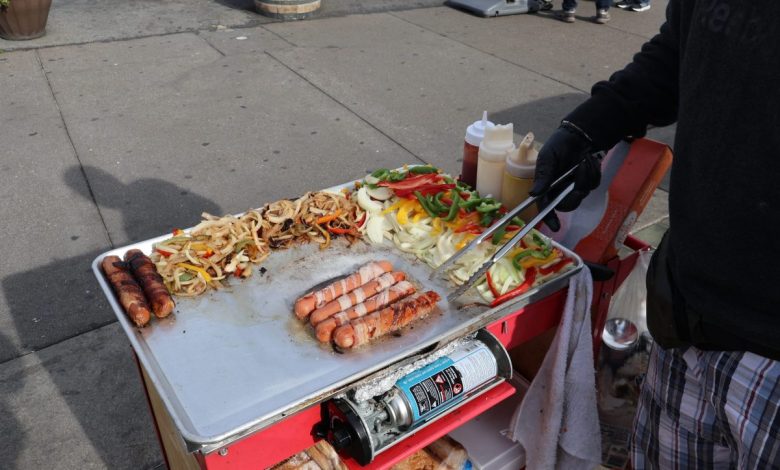Before You Bite That Hot Dog: Expert Tips to Stay Safe with Street Food

Street food is more than just a quick bite—it’s culture, community, and comfort wrapped in paper and served with a smile. Whether it’s a hot dog from a bustling New York corner, tacos from a food truck in Los Angeles, or spicy samosas sizzling in an Indian bazaar, street food has a charm that formal dining often can’t replicate.
But as mouthwatering as these delights can be, there’s always that little voice in the back of your head asking: Is this safe to eat?
The reality is, while street food is delicious and often affordable, it can sometimes come with hidden risks—foodborne illness, contamination, or poor hygiene practices. The good news? You don’t have to give up your love for hot dogs, kebabs, or dumplings. With a few smart tips and expert insights, you can indulge in your favorite treats while keeping your health intact.
This article explores street food safety tips, expert recommendations, and practical strategies to make sure the next time you’re tempted by that hot dog stand, you can bite in without a worry.
Why Street Food Is So Popular
Before diving into safety, it’s worth understanding why street food has such a universal appeal.
- Affordability – Street food is usually cheaper than restaurant dining, making it accessible to almost everyone.
- Convenience – On the go? Street food vendors are often located in busy areas where you can grab a quick bite.
- Cultural Experience – Street food often reflects authentic, traditional recipes that give you a taste of local culture.
- Fresh and Flavorful – Many vendors cook food right in front of you, offering freshness and irresistible aromas.
The combination of cost, culture, and convenience explains why billions of people worldwide rely on street food daily.
Expert Tips for Staying Safe with Street Food
1. Choose Vendors with High Turnover
If you see a long line of customers, that’s usually a good sign. Busy vendors constantly cook fresh batches of food, meaning it’s less likely to sit around at unsafe temperatures.
Pro Tip: Avoid stalls where food looks like it’s been sitting in trays for hours.
2. Watch the Cooking Process
One of the biggest advantages of street food is transparency. Unlike restaurants where food disappears into a kitchen, you can often see everything being prepared right in front of you.
- Look for sizzling, steaming, or boiling—heat kills bacteria.
- Make sure meats (like hot dogs, chicken, or kebabs) are fully cooked through, not raw in the center.
- Fried foods should be crisp, not soggy with old oil.
3. Check the Vendor’s Hygiene
A clean vendor is usually a safe vendor. Pay attention to:
- Whether they use gloves or tongs (instead of bare hands).
- If they have access to clean water for washing.
- The general cleanliness of the stall—does it look maintained or neglected?
Red Flag: If a vendor is handling money and food without washing their hands in between, be cautious.
4. Be Careful with Condiments
Street food often comes with sauces, chutneys, or toppings. These can be delicious—but risky if not stored properly.
- Avoid condiments sitting out all day in the sun.
- Choose sealed packets of ketchup, mustard, or mayo over open bowls.
- If sauces are freshly made in front of you, even better.
5. Stick to Cooked Foods
While salads, raw veggies, or uncooked toppings may look appealing, they’re also the riskiest items when it comes to contamination.
Rule of Thumb: If it’s cooked hot, it’s usually safe.
6. Trust Your Senses
Your eyes, nose, and taste buds are powerful tools for detecting unsafe food.
- Does the food look fresh and vibrant—or dull and old?
- Do you notice any foul or sour smell?
- Does the taste seem “off”?
When in doubt, don’t eat it.
7. Mind the Environment
The location of the stall matters. Street food near heavy traffic may be exposed to dust, smoke, and pollution. Choose vendors who cover their food or operate in slightly less congested areas.
8. Avoid Ice in Drinks
In many parts of the world, ice is made with unfiltered tap water, which can carry harmful microbes. Unless you’re certain the ice is made with safe, purified water—skip it.
9. Stay Hydrated and Balanced
Street food is often salty, fried, or spicy, which can dehydrate you. Always carry clean bottled water and try to balance indulgence with fresh fruits or lighter meals elsewhere.
10. Know Your Own Stomach
Some people are more sensitive to unfamiliar spices, oils, or bacteria. If you’re traveling abroad or have a weaker digestive system, start with milder, safer options before trying riskier foods.
Street Food Around the World: Safety Insights
Street food isn’t just about hot dogs—it’s a global phenomenon. Let’s take a quick tour of popular street foods and their safety tips:
- USA – Hot Dogs, Pretzels, Tacos: Ensure meats are piping hot, buns are fresh, and condiments are stored properly.
- Mexico – Tacos, Elotes, Churros: Stick with cooked fillings, avoid raw lettuce or salsa that’s been sitting out.
- India – Samosas, Chaat, Pani Puri: Favor fried items like samosas over raw water-based snacks like pani puri (unless from a trusted vendor).
- Thailand – Pad Thai, Satay, Mango Sticky Rice: Look for freshly cooked stir-fries; avoid pre-cut fruits left uncovered.
- Middle East – Shawarma, Falafel, Kebabs: Ensure shawarma meat is shaved from a hot, rotating spit and not reheated from earlier in the day.
The Risks Hidden Behind Street Food
While tempting, street food can carry certain health risks if vendors don’t follow proper safety practices. Some common concerns include:
- Foodborne Illness – Caused by bacteria like E. coli, Salmonella, or Listeria that thrive in improperly stored food.
- Cross-Contamination – When raw and cooked foods share utensils, cutting boards, or prep surfaces.
- Poor Hygiene – Dirty hands, unwashed vegetables, or contaminated water can spread illness quickly.
- Improper Cooking Temperatures – Undercooked meats (like hot dogs, kebabs, or chicken skewers) can harbor dangerous pathogens.
- Environmental Contamination – Dust, pollution, and insects in outdoor setups increase exposure risks.
What Nutrition Experts Say
Nutritionists often warn that while street food can be delicious, it’s not always the healthiest option. Common issues include:
- High in Oil and Fat – Many items are deep-fried.
- Too Much Salt – Hot dogs, fries, and kebabs are often sodium-heavy.
- Lack of Vegetables – Unless you add sides, street food meals are rarely balanced.
Expert Advice: Enjoy street food as an occasional treat, not a daily diet staple. Pair it with fresh fruit, vegetables, and plenty of water to balance your intake.
How to Build a “Street Food Survival Kit”
If you’re a frequent street food lover, consider carrying a few items with you:
- Hand sanitizer or wet wipes (for before and after eating).
- A reusable water bottle with safe water.
- A small packet of tissues or napkins.
- Over-the-counter remedies for indigestion, just in case.
This little kit ensures you’re prepared to enjoy without unnecessary worries.
Street Food and Travel: Extra Caution for Tourists
If you’re traveling, street food can be one of the best ways to experience local flavors. But tourists are often more vulnerable to foodborne illness because their stomachs aren’t used to the local bacteria.
Travel Tips:
- Start small—don’t dive straight into the spiciest or heaviest dish.
- Avoid drinking tap water or anything made with it.
- Choose vendors recommended by locals or online reviews.
Remember, what locals can eat daily without issue might not sit as well with you.
The Bottom Line: You Don’t Have to Skip Street Food
Street food is not the enemy—it’s a treasure trove of flavors, traditions, and affordable meals. The trick is knowing how to enjoy it safely.
So before you bite that hot dog, pause for just a moment. Ask yourself:
- Is this vendor clean and busy?
- Was my food cooked in front of me?
- Do the condiments and toppings look safe?
If the answer is yes, go ahead and enjoy every bite.
Final Thoughts
Street food is a celebration of culture, flavor, and accessibility. Yes, there are risks—but with awareness, observation, and smart choices, you can enjoy your favorite hot dog, taco, or kebab without fear.
The next time you’re tempted by the aroma of grilled sausages on a city corner, don’t hold back. Just remember these expert tips, trust your instincts, and savor the experience safely.
Because at the end of the day, street food isn’t just about eating—it’s about connecting with the world around you, one bite at a time.




